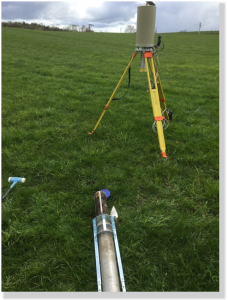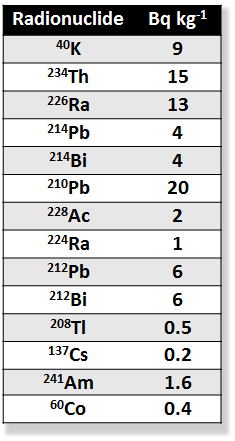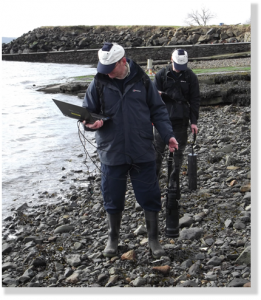
One of the core strengths we possess here at ERL is our ability to make highly accurate field measurements to infer certain characteristics of radioactivity in the environment, for instant dose rate or concentration of a radionuclide in the soil. Our founder, Professor Andrew Tyler, who is an internationally recognised through his work in this field, made sure this capability was one of the key ingredients in setting ERL aside from conventional sampling laboratories.
In situ gamma-ray spectrometry
In the early days of ERL, particularly driven by the need to characterise contamination derived from Chernobyl, much effort was concentrated in understanding the response of our in situ instruments. Building upon this knowledge, today we now offer a 70% (relative efficiency) n-type HPGe detector mounted on a surveyors stand.

These types of detectors offer the highest energy resolution obtainable, which once fully calibrated can measure almost any gamma-emitting radionuclide. This includes the natural radiation from K-40 and daughter radionuclides from the Uranium and Thorium series. Anthropogenic radionuclides such as Cs-137, Cs-134, I-131, Am-241 and Co-60 have all been measured using this equipment. Approximate detection limits are summarised in the table to the left. An alternative lower energy resolution 71 φ × 71 mm sodium iodide detector can be operated in the same manner without the need to be cooled by liquid nitrogen.
It has been a priority to demonstrate the continued quality of performance of our instruments and compare, share and learn from our international colleagues. Subsequently, ERL has taken part in a number of in situ intercomparison exercises over the years including EURADOS (Germany), ECOMAGS (Scotland) and more recently GAMFAC (Belarus).
Mobile gamma-ray spectrometry
Lightweight computers that require significantly less power have allowed ruggedised mobile systems to be developed. In 2013, alongside the Scottish Environment Protection Agency we developed our own mobile system coined MoGSS (Moblie Gamma-ray Spectrometry System). Operated alongside high accuracy GPS, this system is typically utilised to make a large number of short count time measurements. which can enable them to map significant areas in much higher resolution.
Currently, we operate handheld 71 φ × 71 mm sodium iodide detectors, which are particularly useful in characterising remote and/or rugged contaminated land. Such instruments are ideal for radioactive source retrieval and hot spot location.
 Moreover, MoGSS can be operated on much larger detection volumes, for example we use eight litres of sodium iodide crystal mounted to a vehicle (on top of or at the rear) or a heavy duty trolley. Significantly much larger detection efficiency can be obtained using this setup making background mapping more effective. In a similar way, identifying the activity of diffuse contamination can be performed more efficiently.
Moreover, MoGSS can be operated on much larger detection volumes, for example we use eight litres of sodium iodide crystal mounted to a vehicle (on top of or at the rear) or a heavy duty trolley. Significantly much larger detection efficiency can be obtained using this setup making background mapping more effective. In a similar way, identifying the activity of diffuse contamination can be performed more efficiently.
Gamma Dose Rate
Gamma dose rate measurements are employed within much of our work and to establish accurate dose rates we use calibrated Thermo Series 6-80, which are fully UKAS accredited. Currently, we can operate two air kerma kits any one time.
Beta Dosimetry
In situ beta dosimetry is conducted using a Thermo Fisher Electra 1B with BP19RD probe or a Berthold LB122 with LB6357 Beta/Gamma probe. Sampling teams are fully accredited for the deployment of these instruments.
